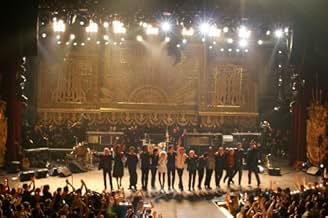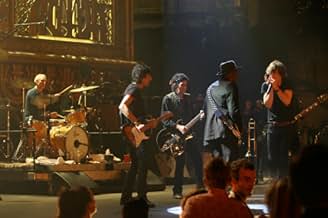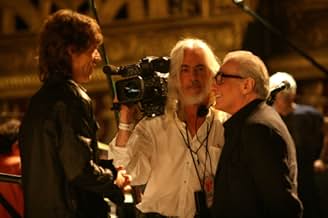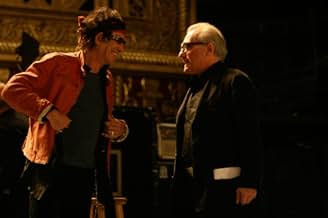Para comemorar os 45 anos de uma das maiores bandas de rock de todos os tempos, The Rolling Stones, o consagrado diretor de cinema Martin Scorsese registrou dois shows muito especiais no Bea... Ler tudoPara comemorar os 45 anos de uma das maiores bandas de rock de todos os tempos, The Rolling Stones, o consagrado diretor de cinema Martin Scorsese registrou dois shows muito especiais no Beacon Theater de Nova York.Para comemorar os 45 anos de uma das maiores bandas de rock de todos os tempos, The Rolling Stones, o consagrado diretor de cinema Martin Scorsese registrou dois shows muito especiais no Beacon Theater de Nova York.
- Prêmios
- 4 indicações no total
- Self - The Rolling Stones: trumpet
- (as Kent Smith)
- Self
- (as Jack White III)
Avaliações em destaque
1. "May the good lord shine a light on you Make every song your favourite tune"
2. "You call yourself a Christian, I call you a hypocrite. You call yourself a patriot, well I think you're full of sh*t."
Both are recent songs by the Rolling Stones. A 1960s rock and roll group. (Band members are now in their sixties.)
Verse 2 is from an anti-Bush song called Sweet Neo Con. An interesting point from which to start a movie perhaps. Veteran director Scorsese even chooses a concert at which democrat Bill Clinton is in attendance. But the song, even though part of the tour, is missing. This film has no hidden agenda or meaning. Sweetness and Light. Shine a Light.
If you are a current fan of the Stones, such details matter little. This is a concert film (at the New York Beacon Theatre) to die for. Production values are far better than any comparable TV live event. A concert to enjoy in surround sound, in a comfortable theatre, with every detail up close on a big screen (or even IMAX). Not a film about lyrics. Not a documentary of these extraordinary long careers. Just a big, brilliant concert.
It rather feels as if the Stones hired the best filmmaker in the business. Who in turn hires the best cinematographers. Who in turn capture every dramatic gesture. Every Mick Jagger mince. Every crowd-pleasing wave. Each impressive guitar riff. Each colourful stage contrast. Each theatrical burst of light. Everything. Except film fans may struggle and ask, "But isn't this supposed to be a Martin Scorsese film?"
When Scorsese did Bob Dylan (No Direction Home), his achievement was in the insights into a complex man. His film resolved the eternal conflict between Dylan's public personas. Shine a Light, on the other hand, offers no such insight into the stars concerned beyond the current state of their stage performance (impressive though it is).
There are some nice cinematic touches. It is fun watching Scorsese in front of the camera in the opening scenes. He worries about getting a specific playlist, so he knows whether to be ready for a guitar solo or singer acrobatics. It helps us understand the complexity of filming a live event. The question of the band's age, instead of being disguised, is cleverly made a feature. Scorsese intersperses Beacon Theatre sets with vintage black and white footage of frequent interview questions relating to age. "Can you imagine doing this when you're 60?" and so on. I wince. I had qualms about watching these pensioners prance about on stage. A fan of their early music, I instinctively feel rock stars should die (or at least retire) before they get old. But blues singers look cool old. Why not the Rolling Stones? Keith Richards looks positively cadaverous. A Munster with a mean guitar. And the Rolling Stones are considered chic both by baby boomers and trendy young well-to-dos. Long gone are the days when buying a Stones album was an act of defiance.
But in spite of the unused Neo Con lyrics and Jagger's single use of the f word in the whole concert, fans seem more concerned that Richards actually smokes a cigarette. A girl in the audience points disapprovingly. The Stones are mainstream. Bill Clinton hails their green credentials. Everyone is lovey-dovey. Much of the concert features impressive showmanship and a high level of professionalism. Jagger never misses a note. The guitar-work is beautiful. And as a role model for pensioners, Jagger's routine is more energetic than any step class. But where was the angst? The blinding energy that seared itself into the brains of the 60s youth? This was a very a different band. I try to forget the old one. I enjoy the toothless new more than I like to admit.
Shine a Light is a time capsule. The latter years of the most famous rock and roll band in the world. A great British institution preserved for posterity. (It releases the day after Gordon Brown's jovial and equally polished tele-appeal on American Idol. New Labour. New Stones.)
Well-chosen guest artists spring into sets. Jack White produces a perfect blend of young and old as he duets with Jagger. Christina Aguilera looks stunning in high heels and tights. How could she not fire up the old man? Jagger hugs her bum as they dance to Live With Me. He has new fire in him as he continues with Start Me Up. By the time he sings Brown Sugar, there is a passion to it. The audience wave and cheer in time. When Satisfaction ricochets through the hall it is like watching the legend. The Mick Jagger of old. I'm almost a convert.
Would it be cynical to say Sympathy for the Devil looked more like a Born-Again pageant? Unappreciative perhaps. The film lover in me would rather have Jean-Luc Godard's film of that title for a sense of the 'real' Rolling Stones. But why should audiences dictate that pop stars or film directors for that matter conform to expectation? Accept Shine a Light for the awesome concert film that it is. Miserable old sentimentalists go back to your vinyl. Your 'creative' cinema. There's not much of it here.
"Shine a Light" is a concert film. I'm not sure I'd call it a documentary on the Rolling Stones so much as a filming (a brilliant filming) of an especially good concert they played recently. Scorsese is smart enough, however, to use interviews and clips from all stages of the Stones' career for purposes of humor and even commentary on various aspects of music and the music business, as well as the band itself.
Your average Rolling Stones fan waiting to see a Rolling Stones concert and who isn't a fan of film probably will be bored during the film's opening scenes, but for those interested in film, they provide a fascinating glimpse into the marriage of live music and film-making, which doesn't happen as much as it should. It's also quite an intimate look at the Stones as a bunch of people, exposing them in the same sort of way the non-concert scenes in "Gimme Shelter" did. Then again, how much of it is real and how much is an act is really the essential question that we will forever be asking about this band.
"Shine a Light" isn't a document of an important historical event like Scorsese's "The Last Waltz" or the Maysles Bros' "Gimme Shelter" was as a Rolling Stones film, so one shouldn't expect that sort of greatness from "Shine a Light". What one should expect is a great concert, filmed with great skill, tasteful guest appearances that do nothing but add to the music, and a gorgeous film interspersed tastefully with archive footage chosen carefully and played at just the right moments.
The Stones and Scorsese are on top form here, making this a memorable and exciting concert film and the sort of marriage of film-making and live music that really should happen more often.
8.5/10
For one, the enormous video screens make every seat great. Beyond that, it was the Rolling Stones that won me over. Rocking songs, incredible performances, unbelievable energy, and every one in the crowd dancing and singing the whole show. And these guys are in their sixties! Watching 'Shine a Light' on IMAX at times made me feel like I was actually at a live Stones concert, but then I kept feeling that something key was missing. And it was.
Martin Scorsese covered the two explosive shows at the Beacon Theater in New York with 18 cameras but he somehow missed getting the band. As expected, lead singer and ringmaster, Mick Jagger, gets the most screen time, with guitarist, Keith Richards, coming in a not too distant second. And then there's Ron Wood, the second guitarist, and some might argue, the better soloist, He has juicy moments on screen, but is shockingly absent time and again when soloing, the camera instead lingering on a prancing Jagger or posing Richards.
And where is drummer Charlie Watts? Watching 'Shine a Light' one might think the Stones had backing tracks instead of a live drummer. Watts is the quiet one (who doesn't dye his hair) but he's the backbone of their sound, keeping time, holding it down while the boys jump around. I kept wanting to see shots of Watts, not only for the variety of imagery and the visual reinforcement that there really is a live drummer hitting the cowbell on 'Honky Tonk Women,' but also because he's an original Rolling Stone. Sadly, there are only a handful of very brief clips featuring Watts, and just as few wide shots of the whole band on stage. And Watts is not the only one nearly absent from the movie.
Although the original members are Jagger, Richards, Watts and Wood (Wood joined in 1974 so he's not actually an original Stone), they tour with a number of key support musicians, including bass player, Daryl Jones (who's worked with them since 1994), a keyboardist, a horn section and three back-up singers. However, except for some brief interplay between Jagger and the back-up singers, the other musicians are absent from the film. It's not so unusual to relegate non-member, support players to minor roles in concert movies, but to avoid them altogether is baffling and frustrating.
The support musicians may not be Rolling Stones but they are a part of the band. They are playing the music and adding to the sights and sounds on stage. But 'Shine a Light' mostly kept them in the dark. This isn't how a real concert is experienced. In concert the other players are seen and often featured in the spotlight as soloists. But time and again in 'Shine a Light', we hear a piano riff, a sax solo, a horn section blast, a bass run, but we never actually see who's playing. We neither get full nor medium shots, nor even close-ups of hands playing. We don't even get quick cuts of the support players, as one might see interspersed regularly throughout most filmed live concerts today. Instead, we see lingering shots of Jagger and Richards, sometimes so close you can see the brown behind Jagger's teeth, while a saxophone or some other player wails somewhere off-camera. The Stones sound is some much more than guitar, bass, drums and vocals. A concert is so much more than the starring players, but you don't get that from this film. It's as if the film makers had tin ears.
This is baffling because they had 18-camera shooting the action. So the film makers either didn't get the coverage, or they decided in the editing room not to include the other players. Bad decision. This gives the movie, the Stones concert experience, a frustrating myopic feel. I kept wanting to see what I was hearing, but couldn't. I kept wanting to get a visual of the focal point in the song and on stage, but it was not delivered. Even one of the few times Jaggar plays harmonica is off-camera. This left me feeling short-changed.
Ultimately, 'Shine a Light' is slightly claustrophobic, with all its medium and close shots. It rarely opens up to show the entire band on stage. The film suffers as a result, as wide shots would have provided much needed breathing room, offering a more open perspective, and also providing the myriad tight shots with context. We do see the interplay between Jagger and Richards, or between Richards and Wood, but we don't see the whole band working together as a unit. And ultimately that's what a live Stones show, or any live rock show is all about--a group of individuals performing together as a band. Even if Scorsese decided that the film was all about the four Stones, he could have easily divided the enormous screen into quads, now and again, so we could see the four Stones working their magic simultaneously in a multi-screen format. This is common place today and highly effective.
It's baffling that with all the resources at hand and experience behind him, Scorsese didn't quite deliver the goods. It's as if his infatuation with the visages of Jagger and Richards blinded him from showing us the Rolling Stones. 'Shine a Light' is enjoyable for sure, but suffers from a limited vision.
You certainly have the concert feeling here. But Stones have made it both better and worse. There are ups and downs in this performance, with an absolute peak from the blues man Buddy Guy entering stage.
The clips from old Stones interviews are entertaining, but what's the purpose of having them there? If they are supposed to be included, they should have taken a bigger place, telling something more of this band, which in itself forms essentials of rock history. Anyway, good work by Scorsese, although traditional.
It might be easy to adulate the Stones, as well as Scorsese. They've been around for so long, doing what they do, with each side rumored here and there to quit doing what they do (for the Stones it's every tour, much to their grinning bemusement, and for Scorsese it was a point in the 80s when he thought he'd have to leave Hollywood and make documentaries on saints). They're always acclaimed, usually big money-makers, and they've acquired a kind of nether-region between 'cult' audience and full-blown mainstream mayhem. It's this that is, in a way, the subtext for Shine a Light. While Scorsese stays mostly behind the scenes, the Stones are up and front and in center of a marvelous performance, and showcasing the energy and level of pizazz that quiets the naysayers. They sold out, and it doesn't get to them a single bit.
After some funny early footage of Scorsese (shot usually in black and white DV by Albert Maysles, who also appears here and there) getting into a minor tizzy about what the set-list is going to be, and getting some downtime with Bill Clinton, the show starts up like any good Stones show should- Jumpin' Jack Flash. Then onward come some given numbers (Shattered, Brown Sugar, Tumbling Dice), the masterpieces (Sympathy for the Devil, Loving Cup, featuring an awesome Jack White, and Champagne and Reefer with an equally awesome Buddy Guy), and a lot of unexpected tracks too (Live with Me with showy Aguilera, As Tears go By, some country song, and a kick-ass She Was Hot). For fans it's an amazing mix, and it allows for those who are just casual admirers to get their money's worth, primarily in IMAX. This is not just because of the quality of the music and the performances- which is, at its best, revelatory of what this band can do, at any age- but because of Scorsese's cameras, moving around in epic and roving fashion, edited with efficiency to not go all over the place or too slow, and, chiefly, to make it intimate like how many remember the Last Waltz to be (lots of neatly defined close-ups, lingering on to capture these hardened rockers).
And at the end, what is the point? Is it just another blah-blah Stones concert movie? Not necessarily. It doesn't have the heavy sociological context of Gimme Shelter, however it's not a little sloppy like Let's Spend the Night Together. Shine a Light celebrates its heroes, but it doesn't go completely overboard. Scorsese knows, as he did with Bob Dylan, not to get too cocky with these fogies. It's important to throw in those bits with the Stones getting interviewed, candid and without much overbearing ego present, and by the end you know there's still a place for them, firmly, in the public consciousness. They sold out in the most ironically good way in rock music history, with Scorsese now wonderfully in tow. A+
Você sabia?
- CuriosidadesBruce Willis can be seen in the audience wearing a yellow hat.
- Citações
Martin Scorsese: Catch on fire? We can't do that. We cannot burn Mick - we cannot burn Mick Jagger... We want the affect, but, we cannot burn him.
- Cenas durante ou pós-créditosFrom end credits: Every day the Clinton Foundation works to make a difference by finding real and tangible solutions to some of the world's most pressing challenges, including HIV/AIDS, climate change, global poverty, child obesity and many more. For more information visit www.clintonfoundation.org
- ConexõesEdited into The Rolling Stones: Shine a Light Movie Special (2008)
- Trilhas sonorasI Can't Be Satisfied
Written by Muddy Waters (as McKinley Morganfield)
Performed by Muddy Waters
Courtesy of Watertoons Music, administered by BUG
Courtesy of Epic Records, By Arrangement with Sony BMG Music Entertainment
Principais escolhas
- How long is Shine a Light?Fornecido pela Alexa
Detalhes
- Data de lançamento
- País de origem
- Idioma
- Também conhecido como
- Rolling Stones: Shine a Light
- Locações de filme
- Empresas de produção
- Consulte mais créditos da empresa na IMDbPro
Bilheteria
- Faturamento bruto nos EUA e Canadá
- US$ 5.505.267
- Fim de semana de estreia nos EUA e Canadá
- US$ 1.488.081
- 6 de abr. de 2008
- Faturamento bruto mundial
- US$ 15.773.351
- Tempo de duração
- 2 h 2 min(122 min)
- Cor
- Mixagem de som
- Proporção
- 1.85 : 1






































